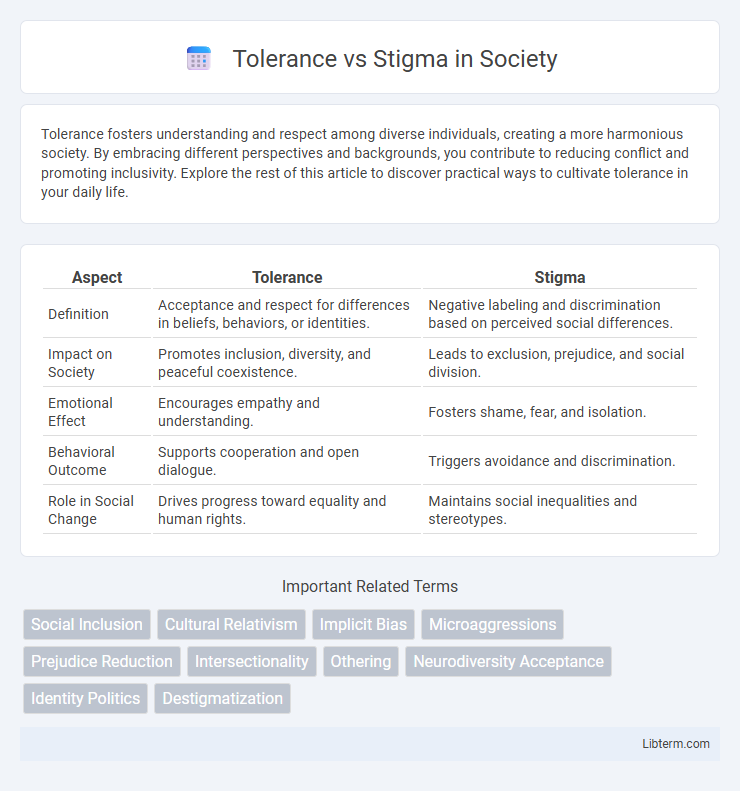Tolerance fosters understanding and respect among diverse individuals, creating a more harmonious society. By embracing different perspectives and backgrounds, you contribute to reducing conflict and promoting inclusivity. Explore the rest of this article to discover practical ways to cultivate tolerance in your daily life.
Table of Comparison
| Aspect | Tolerance | Stigma |
|---|---|---|
| Definition | Acceptance and respect for differences in beliefs, behaviors, or identities. | Negative labeling and discrimination based on perceived social differences. |
| Impact on Society | Promotes inclusion, diversity, and peaceful coexistence. | Leads to exclusion, prejudice, and social division. |
| Emotional Effect | Encourages empathy and understanding. | Fosters shame, fear, and isolation. |
| Behavioral Outcome | Supports cooperation and open dialogue. | Triggers avoidance and discrimination. |
| Role in Social Change | Drives progress toward equality and human rights. | Maintains social inequalities and stereotypes. |
Understanding Tolerance and Stigma
Tolerance involves recognizing and respecting differences in beliefs, behaviors, and identities without prejudice, fostering an inclusive and harmonious society. Stigma arises from negative stereotypes and discrimination, leading to social exclusion and psychological harm for marginalized groups. Understanding tolerance and stigma requires examining their psychological, social, and cultural impacts to promote empathy and reduce social barriers.
Historical Perspectives on Tolerance and Stigma
Historical perspectives on tolerance reveal that societies have often oscillated between acceptance and rejection of marginalized groups based on cultural, religious, and political contexts. Stigma has historically been used as a social mechanism to control and marginalize individuals or communities perceived as different or threatening to dominant norms. The evolution of tolerance reflects gradual shifts towards inclusivity and human rights, while stigma persists as a barrier to social integration and equality.
Social and Cultural Roots of Stigma
Stigma originates from deep-seated social and cultural norms that define acceptable behaviors and identities, often marginalizing those who deviate from these expectations. Cultural beliefs, traditions, and historical contexts reinforce negative stereotypes, perpetuating discrimination and social exclusion. Understanding these roots is essential to fostering tolerance, which challenges prejudiced attitudes and promotes inclusive acceptance across diverse communities.
Psychological Impact of Stigma
Stigma related to mental health can cause significant psychological distress, including feelings of shame, isolation, and decreased self-esteem. These negative impacts often lead to avoidance of help-seeking behaviors, exacerbating mental health conditions and hindering recovery. In contrast, tolerance fosters acceptance and support, promoting psychological well-being and encouraging individuals to seek timely treatment.
Benefits of Fostering Tolerance
Fostering tolerance reduces social stigma by promoting acceptance and understanding across diverse communities, which enhances mental health outcomes and social cohesion. Increased tolerance encourages inclusive policies and equitable treatment, driving economic growth through diverse workforce participation and innovation. Creating tolerant environments minimizes discrimination, thereby improving access to education, healthcare, and employment for marginalized groups.
Common Barriers to Tolerance
Common barriers to tolerance include deep-seated prejudice, lack of education, and fear of the unknown, which perpetuate stigma in societies. Misconceptions and stereotypes about different social, cultural, or religious groups often prevent open-mindedness and acceptance. Structural inequality and social exclusion further reinforce intolerance, making it difficult for marginalized communities to achieve equality and respect.
Real-World Examples: Tolerance vs Stigma
Tolerance promotes acceptance and respect for diversity, as seen in the increased workplace inclusion of LGBTQ+ employees, where policies protect rights and reduce discrimination. In contrast, stigma manifests in societal behaviors such as the marginalization of individuals with mental health issues, leading to exclusion and inadequate access to care. Real-world examples highlight how tolerance fosters social cohesion, while stigma perpetuates inequality and isolation.
Strategies for Reducing Stigma
Effective strategies for reducing stigma involve education campaigns that increase awareness and understanding of mental health conditions, promoting empathy and acceptance. Peer support programs and community engagement create safe environments where individuals feel validated and empowered to share their experiences without fear of judgment. Policy reforms emphasizing anti-discrimination laws and inclusive healthcare access further dismantle systemic barriers contributing to stigma.
The Role of Education in Promoting Tolerance
Education plays a critical role in promoting tolerance by fostering understanding and empathy towards diverse cultures, beliefs, and identities. Curriculum that includes comprehensive diversity training and anti-bias education helps reduce stigma by challenging stereotypes and misinformation. Schools and educational institutions serve as foundational platforms for cultivating inclusive attitudes, which contribute significantly to social cohesion and the reduction of discrimination.
Building a Society of Inclusion and Respect
Promoting tolerance over stigma cultivates a society where diversity is celebrated and individuals feel valued regardless of differences in race, gender, or beliefs. Inclusion drives equitable opportunities and mutual respect, reducing discrimination and social exclusion. Embracing these principles fosters community well-being and strengthens social cohesion across cultural and demographic lines.
Tolerance Infographic

 libterm.com
libterm.com